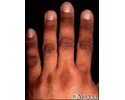Acanthosis nigricans
AN; Skin pigment disorder - acanthosis nigricans
Acanthosis nigricans (AN) is a skin disorder in which there is darker, thick, velvety skin in body folds and creases.
Causes
AN can affect otherwise healthy people. It can also be related to medical problems, such as:
-
Genetic disorders, including
Down syndrome
Down syndrome
Down syndrome is a genetic condition in which a person has 47 chromosomes instead of the usual 46.
Read Article Now Book Mark Article - Hormone disorders, such as diabetes, obesity
- Cancer, such as cancer of the digestive system, liver, kidney, bladder, or lymphoma
- Some medicines, including hormones such as human growth hormone or birth control pills
Symptoms
AN usually appears slowly and doesn't cause any symptoms other than skin changes.
Eventually, dark, velvety skin with very visible markings and creases appears in the armpits, groin and neck folds, and over the joints of the fingers and toes.
Sometimes, the lips, palms, soles of the feet, or other areas are affected. These symptoms are more common in people with cancer.
Exams and Tests
Your health care provider can usually diagnose AN by looking at your skin. A skin biopsy may be needed in rare cases.
Skin biopsy
A skin lesion biopsy is when a small amount of skin is removed so it can be examined. The skin is tested to look for skin conditions or diseases. A...

If there is no clear cause of AN, your provider may order tests. These may include:
- Blood tests to check blood sugar level or insulin level
-
Endoscopy
Endoscopy
Endoscopy is a way of looking inside the body using a flexible tube that has a small camera and light on the end of it. This instrument is called an...
 ImageRead Article Now Book Mark Article
ImageRead Article Now Book Mark Article -
X-rays
X-rays
X-rays are a type of electromagnetic radiation, just like visible light. An x-ray machine sends individual x-ray particles through the body. The im...
 ImageRead Article Now Book Mark Article
ImageRead Article Now Book Mark Article
Treatment
No treatment is needed, as AN only causes a change in skin color. If the condition is affecting your appearance, using moisturizers containing ammonium lactate or hydroquinone can help lighten the skin. Certain lasers may also help the appearance.
It is important, however, to treat any underlying medical problem that may be causing these skin changes. When AN is related to obesity, losing weight often improves the condition.
Outlook (Prognosis)
AN often disappears if the cause can be found and treated.
When to Contact a Medical Professional
Call your provider if you develop areas of thick, dark, velvety skin.
References
Habif TP. Cutaneous manifestations of internal disease. In: Habif TP, ed. Clinical Dermatology . 6th ed. Philadelphia, PA: Elsevier; 2016:chap 26.
Kia KF, Criz PD. Acanthosis nigricans. In: Lebwohl MG, Heymann WR, Berth-Jones J, Coulson I, eds. Treatment of Skin Disease: Comprehensive Therapeutic Strategies . 4th ed. Philadelphia, PA: Elsevier Saunders; 2014:chap 1.
Patterson JW. Miscellaneous conditions. In: Patterson JW, ed. Weedon's Skin Pathology . 4th ed. Philadelphia, PA: Elsevier Churchill Livingstone; 2016:chap 19.
-
Acanthosis nigricans - close-up - illustration
This photograph demonstrates the hyperpigmented, brownish, velvety lesions of acanthosis nigricans. This skin condition may occur in skin folds such as the axilla (armpit - pictured here), neck, and other areas. In adults, it may be associated with hormonal problems, internal malignancy, obesity, and drugs.
Acanthosis nigricans - close-up
illustration
-
Acanthosis nigricans on the hand - illustration
This photograph demonstrates brownish, hyperpigmented, velvety plaques overlying the metacarpal and interphalangeal joints of the hands.
Acanthosis nigricans on the hand
illustration
-
Acanthosis nigricans - close-up - illustration
This photograph demonstrates the hyperpigmented, brownish, velvety lesions of acanthosis nigricans. This skin condition may occur in skin folds such as the axilla (armpit - pictured here), neck, and other areas. In adults, it may be associated with hormonal problems, internal malignancy, obesity, and drugs.
Acanthosis nigricans - close-up
illustration
-
Acanthosis nigricans on the hand - illustration
This photograph demonstrates brownish, hyperpigmented, velvety plaques overlying the metacarpal and interphalangeal joints of the hands.
Acanthosis nigricans on the hand
illustration
Review Date: 4/29/2016
Reviewed By: Kevin Berman, MD, PhD, Atlanta Center for Dermatologic Disease, Atlanta, GA. Review provided by VeriMed Healthcare Network. Also reviewed by David Zieve, MD, MHA, Isla Ogilvie, PhD, and the A.D.A.M. Editorial team.


